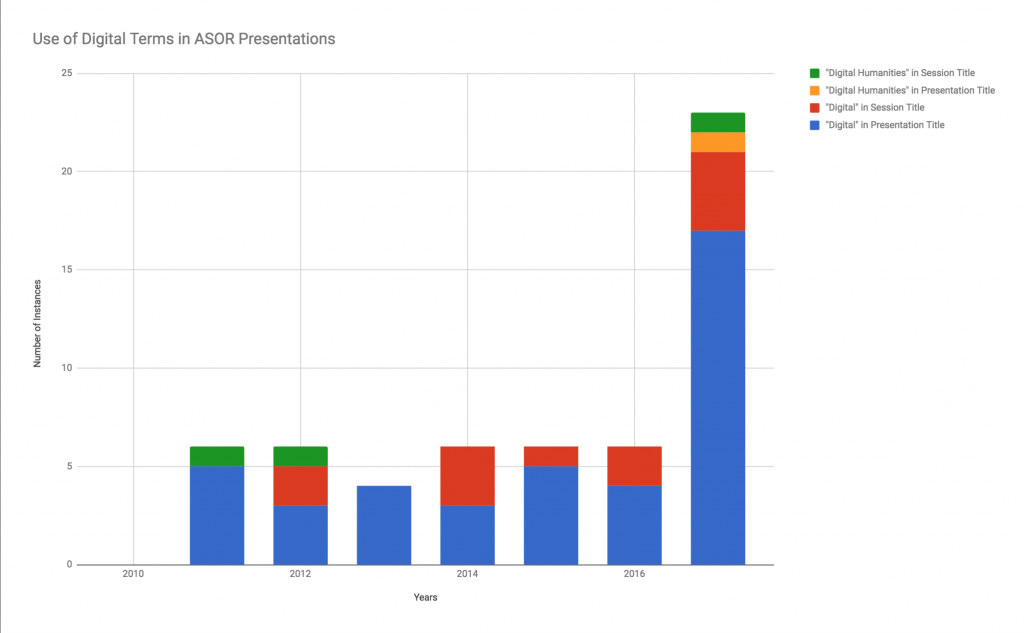
By Humtech RITCs on February 13, 2018
As a scholar of Near Eastern archaeology, I interact with archaeologists, ancient language experts, geographers, art historians, and experts from many related fields. While attending conferences in these areas, I have heard one question gain traction above others: What are (or is) the Digital Humanities?
This is a deceptively simple question with a very complicated answer, one which a number of fields in the humanities are currently addressing. According to the guidelines for the National Endowment for the Humanities (NEH) Digital Humanities Advancement Grants, Digital Humanities projects may include:
creating or enhancing experimental, computationally-based methods, techniques, or infrastructure that contribute to the humanities; pursuing scholarship that examines the history, criticism, and philosophy of digital culture and its impact on society, or explores the philosophical or practical implications and impact of digital humanities in specific fields or disciplines; or revitalizing and/or recovering existing digital projects that promise to contribute substantially to scholarship, teaching, or public knowledge of the humanities.
This is very broad.
According to the NEH, a project that is eligible for Digital Humanities funding utilizes digital technologies to understand the humanities, but this guideline fails to address the intentions behind actually using DH. What, exactly, is it that people think they are doing that makes it DH?
As an example of what this means in one particular field, I will look at one of my favorites, archaeology. Archaeology explores subjects somewhere between humanities and social sciences, but utilizes many techniques pioneered by the more “hard” sciences. This makes it a perfect petri dish with which to watch the Digital Humanities evolve.
In November 2017 I attended the annual meeting for the American Schools of Oriental Research (ASOR), a platform to present and discuss current research on archaeology and material studies in the ancient Near East and Mediterranean world. The three day annual conference has seen a marked increase in the number of presentations and sessions with “digital” or “digital humanities” in the title, from 0 in 2010 to 23 in 2017. A similar trend can be seen when referring to the annual meeting for the Society of Biblical Literature (SBL), the counterpart to ASOR that focuses mostly on the language and literature of the ancient Near East.


This increase in popularity in using digital technologies in archaeology, though, has not made defining “Digital Humanities” any easier. Is it a field? Is it a tool? Is it something else completely? Finding an answer to “What ARE (or IS) the Digital Humanities?” remains problematic.
There was a junior scholars panel at the 2017 ASOR annual meeting by Vanessa Juloux titled “What Exactly Are the Digital Humanities and Why Should Scholars of the Ancient Near East Care?” This was the first time DH at ASOR was addressed so directly but instead of answering the question, it raised more problems. For the presenter, the DH is a toolset to improve her scholarship, answer research questions that philological methods cannot answer, and use digital tools to make certain scholarship easier.
To a certain degree, these are some of the ways that methods provided by DH can address traditionally humanist questions. It does not, however, provide any theoretical means to do so. In a nutshell, it only answers HOW we should use DH, not WHY.
This increase in traction with DH techniques and technologies is clearly reflected in the number of times “Digital” is used in presentation and session titles. But why do we use digital technologies in archaeology? What is the value? This part of the conversation is severely stunted, and where I think things should be directed in the future.
There has been an increasing number of studies that use DH tools without fully asking “why are we doing this?” The answer may just be as simple as “it’s a fun tool,” but in those cases, it’s best to be upfront about it. It isn’t enough to use a new technology and just call it “Digital Humanities” because you used a new (to you) technology. Why that one in particular? Why ArcGIS, or GRASS, or IDRISI, or ERDAS (for the GIS inclined)? Why one set of software over another? What is informing these decisions? And what value is the digital technology actually adding to the analysis and study?
To that effect, I think that any scholar who wants to utilize DH and the theories and methods that go along with it should answer a number of questions before proceeding with their study. Many of these overlap with forming any research projects in the humanities.
- What is your research or pedagogical goal?
- Did you come up with the goal first, and then fit the technology to it?
- Can using digital humanities shed light on your question that other techniques would not be able to elucidate?
- Will your research project add to our knowledge of the technology in addition to the humanities?
- Do you have a sustainability plan for your digital resources?
For now, since Digital Humanities remains a nascent field, these are questions that need to be in the background. The more DH is utilized in the future, the more we need to (and should) directly address these questions.
Main photo (entitled Looking Down the Upper Jordan Valley from Mount Hermon (4879594516).jpg) used courtesy of Wikimedia Commons user OSU Special Collections & Archives : Commons – used as no known copyright restrictions exist. (source: https://commons.wikimedia.org/wiki/File:Looking_Down_the_Upper_Jordan_Valley_from_Mount_Hermon_(4879594516).jpg) Image cropped for content.
Screen shots provided by the author.
Resources:
